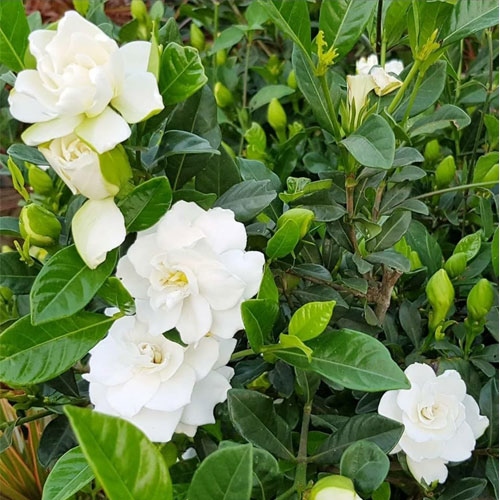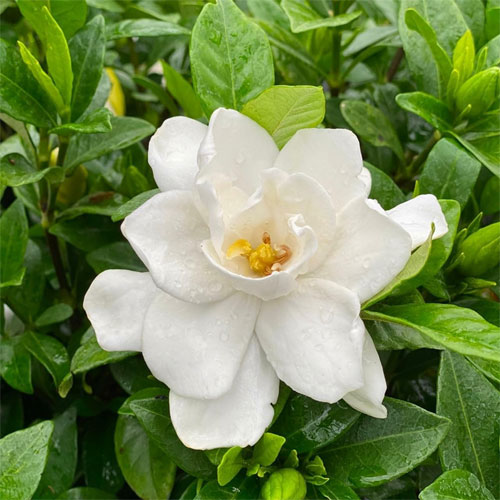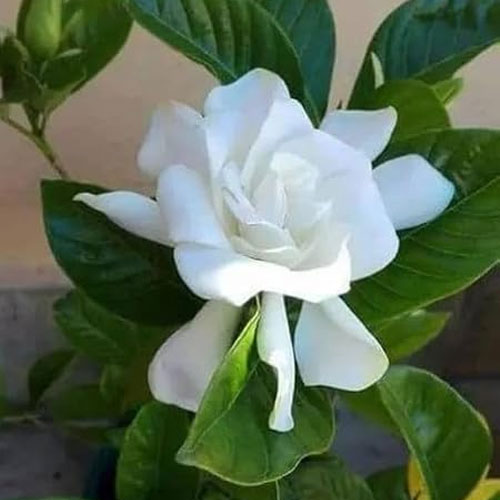Introduce timeless beauty and heavenly fragrance to your garden with the Gardenia Gandharaj Cape Jasmine Live Plant (Gardenia jasminoides) – a stunning evergreen ornamental shrub known for its creamy-white, rose-like blooms and intense sweet fragrance. Revered across Indian homes and temples, this plant is a must-have for every flower lover and gardener who desires both visual charm and divine aroma.
Perfect for home gardens, balconies, temples, or gifting, the Gandharaj (meaning 'King of Fragrance') lives up to its name by producing blooms that fill the air with their heady, soothing scent. This evergreen plant thrives in Indian climates, flowering mainly in summer and early monsoon seasons.
Type of Plant: Live Ornamental Flowering Plant (Gardenia jasminoides)
Germination Time: Not applicable (Live plant)
Hours of Sunlight Needed: 4–6 hours of morning or filtered sunlight
Where to Grow: Balcony, terrace garden, pots, outdoor garden beds
Growing Season: Year-round; peak flowering in summer and monsoon
Seed Sowing Depth: Not applicable
Ideal Climate: Tropical to subtropical regions of India
Bloom Height: Up to 3–4 feet bush height; compact size when pruned
Organic Fertilizer Requirements: Apply compost or neem cake once every 3 weeks
Life Span: Perennial
Ideal Growing Temperature: 18°C to 32°C
Blooming Time: March to August (can bloom intermittently year-round)
Maintenance Required: Moderate
Watering Frequency: 2–3 times a week; do not overwater
Ideal Grow Bag Size: 12×12 inch or larger



What Size Grow Bag is Best For Gardenia Gandharaj Cape Jasmine Flowering Live Plant
Gardenia blooms best in warm, humid Indian summers and early monsoon, thriving from March to August. In South Indian regions like Kerala, Karnataka, and Tamil Nadu, it may flower multiple times a year with adequate sunlight and care. In North and East India, its main bloom is from late spring to early monsoon.
Choose a 12x12 inch grow bag or terracotta pot with drainage holes. Use well-draining acidic soil (red soil + compost + cocopeat). Place it in a semi-shaded location that receives morning sun or filtered sunlight. Keep the soil consistently moist, but avoid waterlogging. Feed with acidic plant fertilizer (like used tea leaves or diluted buttermilk) monthly.
Not applicable – this product is a live plant.
Sunlight: Morning sunlight (4–6 hrs); avoid harsh afternoon sun.
Soil: Well-draining, slightly acidic soil (pH 5.5–6.5).
Fertilization: Use compost, cow dung, or tea compost once every 2–3 weeks.
Pruning: Light pruning after flowering helps in compact growth.
Support and Spacing: No support needed; keep 2–3 feet spacing if in group planting.
Pest Control: Use neem oil spray to control mealybugs and aphids.
Disease Prevention: Avoid waterlogging to prevent root rot.
Mulching: Use cocopeat or dry leaves to retain moisture.
Harvesting: Not for consumption; ornamental only.
The Gandharaj / Cape Jasmine is not just another ornamental plant – it's a symbol of purity and serenity. Its lush green foliage and thick, waxy white flowers bloom with a scent so rich that it perfumes your entire garden. This plant is widely used for puja decorations, temple gardens, and wedding bouquets. It’s also believed to attract positive energy and repel negative vibes, making it popular in Vastu gardening.
Fragrant blooms used for garlands and temple offerings
Ideal plant for Vastu and Feng Shui-based gardens
Natural air freshener with mood-lifting scent
Makes a thoughtful and auspicious gift for plant lovers
Enhances home aesthetics with minimal maintenance
Gardenia prefers acidic soil – avoid limestone or heavy alkaline mixes. Overwatering is a common issue, especially in the rainy season – always ensure drainage. Do not expose it to strong afternoon sun or dry air – it prefers humid conditions. Yellowing leaves can be a sign of iron deficiency or hard water – treat with organic soil acidifiers.
Yellow Leaves: Caused by iron deficiency or hard water – spray diluted ferrous sulfate or apply tea compost.
Bud Drop: Due to temperature fluctuations or dry air – maintain humidity and consistent moisture.
White Fluff (Mealybugs): Spray neem oil once a week to prevent.
Slow Growth: Add organic acidic fertilizer like buttermilk or sour curd diluted in water monthly.
Gandharaj, Gandhapushpa, Gandhraj Flower Plant, Dwaramalli, Kat Mallige, Bhramar Pushpam, Tagar Flower, Gardenia Jasmine, Kundu Malli
Q1. Why is it called Gandharaj?
Because of its strong, royal fragrance – “Gandha” means fragrance and “Raj” means king.
Q2. Will it survive in a flat balcony in a city?
Yes, absolutely. Just ensure good sunlight, pot drainage, and monthly feeding.
Q3. How often does it flower?
Primarily from March to August, but in warm climates, it may flower again in winter.
Q4. Can I use its flowers for worship?
Yes, it's ideal for puja, garlands, and traditional decorations.
Q5. Is it a high-maintenance plant?
No. Once established with the right soil and sunlight, it requires moderate care.
Sign in now to receive a 5% instant discount on your first order when using code WELCOME. Begin your organic journey today!
By logging in, you're agreeing to our Terms of Service and Privacy Policy.
Rahul Iyer
Thoda late delivery hui but plant fresh aur alive tha. Fragrance outstanding hai.
Priya Singh
Plant healthy aur pest free tha. Garden me lagate hi new buds aane lage.
Suresh Reddy
Bahut acha flowering plant. Fragrance long lasting hai. Worth every rupee.
Ritika Jain
Leaves thick aur dark green. Soil moisture maintained thi delivery ke time. Perfect plant.
Manoj Pillai
Golden Hills Farm ka quality product. Plant ekdum fresh aur blooming stage me aaya. 🌼
Kavita Menon
Delivery fast thi aur packaging neat. Plant thoda small aaya but quickly grow kar gaya.
Vikram Rao
Healthy aur fresh plant. White flowers itne fragrant hain ki pura room me khushbu failti hai.
Anjali Joshi
Bahut fragrant plant hai. Garden ke corner me lagaya aur full bloom me amazing lagta hai. 🌸
Deepak Patil
Roots strong aur soil moist thi. Plant balcony me easily grow kar raha hai.
Sneha Nair
Gardenia flowers bahut sundar lagte hain. Daily watering se new shoots aane lage.